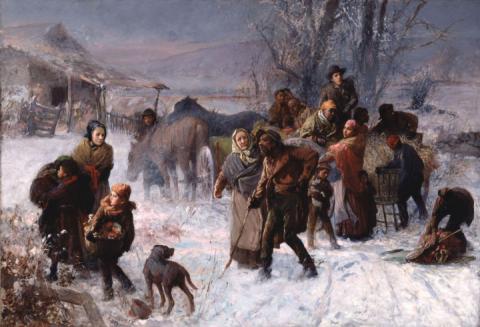"The Underground Railroad," an 1893 painting by Charles T. Webber, depicts the "underground railroad" in action. Three people from Cincinnati - Levi Coffin, Catharine Coffin and Hannah Haydock - help slaves who have escaped. It is believed the setting for this painting is the Coffin farm in Cincinnati. Image online, courtesy Wikimedia Commons.
Underground Railroad routes were located within free states. As though traveling through that territory weren’t treacherous enough, consider that escaping slaves first had to make their way through lands where slavery was legal. In other words, they initially had to travel underneath the underground railroad.
- An escaped slave named "Peter," whose back bears evidence of terrible beatings, told the person who took his picture (in Baton Rouge, April 2, 1863): "Overseer Artayou Carrier whipped me. I was two months in bed sore from the whipping. My master come after I was whipped; he discharged the overseer."
- Several months later, Gordon - a runaway from Mississippi - made it safely to Union lines in Louisiana. His back bore the scars of his master’s whip. After he recovered, Gordon became a Union soldier.
- Thomas Nast, one of the 19th century’s best illustrators, captured the degradations of slavery in a composite drawing which, among other events, shows runaways mauled by pack dogs.
- A large group of African-Americans - like most who were leaving behind a life of slavery - carried all their belongings as they traveled at night.
- On 8 November 1863, a group of African-American escapees reached Union lines near Culpeper Court House, Virginia.
- Fugitive African-Americans had to ford the river in order to safely cross the Rappahannock (in Virginia).
- Most escaping slaves, in search of freedom, did not have the luxury of horse-drawn carriages.
- Slaves risked their lives as they sailed in a small skiff to the New Jersey shore.
- Owners looked upon their slaves as chattel and offered huge rewards for their “merchandise.” One male slave, for example, was worth $100 if captured outside the state of Missouri and $50 if captured within. (Adjusting for inflation, those values would be more than $2,000 and $1,000 today.)
- People escaping north followed the “drinking gourd” (the “Big Dipper”), which points to the North Star.
- Sometimes the mistress of the house took pity on her slaves, as in the case of Wesley Harris:
Wesley’s mistress was kind enough to apprise him of the intention of his owner and overseer, and told him that if he could help himself he had better do so.
Heeding her warning, Wesley and a friend escape from Virginia to Terrytown, Maryland. A man pretending to be a Quaker (members of that religious group often helped runaway slaves) allowed Wesley and his friend to stay in his barn.
It was a setup, however, as Wesley had feared. A serious confrontation in the barn soon followed, and the slaves (after being badly beaten) were recaptured.
Slaves fleeing the south needed help. Some of the most famous “conductors” on the Underground Railroad were former slaves.


 Back
Back
 Next Chapter
Next Chapter

 Back
Back
 Next Chapter
Next Chapter


